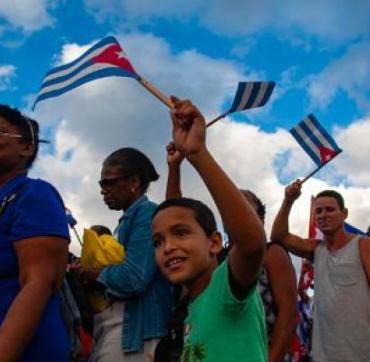Tourism that is coming
especiales

Cautiously but eagerly, tourism in both, Cuba and the world, begins to take off as the pandemic eases up even though Omicron threats with its presence.
The truth is that in addition to the palliative that it means for people, overwhelmed and battered after almost two years of confinement and other restrictions, experts believe that the travel industry is today a significant element in the recovery of economies.
A fact that the World Tourism Organization (WTO) itself, belonging to the United Nations system, agrees with while it estimates that the improvement in this important sector is supported by the reopening of numerous destinations in international itineraries, mainly in Europe and the Americas.
This comes hand in hand with the progress in the application of anti-Covid vaccines, the easing of restrictions in general and, therefore, an increase in the tourists’ confidence when deciding to expand their mobility.
So much so that the UNWTO World Tourism Barometer found that before the end of this disastrous year, during the summer season in the northern hemisphere, there were some signs of recovery, boosting the results of the third quarter of the year, especially in Europe.
In August and September, tourist arrivals stood at -63% compared to 2019 and still were the best monthly results since the outbreak of the pandemic.
However, the resurgence of infections and deaths, which even makes us speak of a new wave, put in jeopardy again the international tourism scene, which were further darkened by the arrival of Omicron, the new strain of Sars-Cov-2.
For this and other reasons, it is worth remembering that returning to the levels of tourism prior to 2019 is not close at all and even today, that takeoff has been uneven as are the immunization levels in the different geographies as well as the health standards.
How did it fare in 2021?
Despite mixed glimmers of revival, this year now ending was just very difficult for tourism worldwide, facing an 80% decline between last January and July, compared to the same period of 2019.
The disparity in the results, as a trend and without much accuracy, corresponds to the way in which the pandemic behaved and as a result, the immunization processes. Consequently, the Asia-Pacific region reported the worst results ever in the first half of the year, with a 95% drop in international arrivals compared to 2019.
The Middle East region recorded the second lowest drop, -82%, followed by Europe and Africa, in both cases with -77%.
In the Americas, tourism showed a somewhat lower decline, -68%, with the Caribbean standing out, boasting the best results as a sub-region.
Particularly some islands in the Caribbean area, and also others in Asia-Pacific and Africa, along with few and small European destinations, reported the best results in the summer —June and July—, which approached and even exceeded figures prior to the pandemic.
The third trimester looked even better, although with uneven results, but arrivals showed figures still below 76% regarding those registered prior to the pandemic.
Hence, the Secretary General of the World Tourism Organization, Zurab Pololikashvili, stated: “These are reasons to remain permanently vigilant and continue our efforts to ensure equitable access to vaccination throughout the world, as well as to have coordinated travel procedures and make use of digital vaccination certificates to facilitate mobility and continue supporting the sector.”
What will it be like in 2022
Experts believe that it may be a crucial year for the world regarding both domestic and foreign tourism considering that there may be fewer mobility restrictions and the progress in the vaccination process.
The future post-pandemic tourism will be aware of the risks and therefore, tourists will make sure of the health safety measures in hotels and means of transportation.
But with this novelty, other different tourist profile —less careful and reluctant to complying with measures, with a more open and flexible behavior— aims to have a clean slate of past, bitter restrictions experienced.
Considering both stances and, firstly, the also uneven and fluctuating epidemiological situation in the world, tourism trends for next year are marked by unique challenges aiming to adapt to new conditions.
This way, new alternatives for tourists will emerge, being working from hotels one of those novelties already emerging. This is the result of the fact that these years proved the effectiveness of teleworking and remote work. Hence, the hotel sector has already enabled fully equipped rooms for work activities, laptops, and facilitators for videoconferencing and other activities.
From now on, nature tourism gains prominence as open spaces are the opposite of previous confinement.
The Secretary General of the UNWTO, Zurab Pololikashvili, stated in the 24th meeting of the General Assembly of that organization, held in Madrid from November 24th to December 3rd: "Guided by the UNWTO, world tourism faces today's challenges, while looking to tomorrow's opportunities. The UNWTO General Assembly shows the sector's determination to start again, lead the recovery and be a central pillar of sustainable development and climate action."
Regarding this last statement, together with the classic family tourism, business and events tourism, medical tourism and the aforementioned nature tourism, sustainable tourism is also making its way and is here to stay.
Hence, in line with international appeals and exhortations, this way of understanding life finds resonance in tourism activity and its protagonists increasingly embrace the importance of protecting recreational sites by respecting the environment and its heritage.
This welcome trend is positioned to such an extent that there are already tourists who take these into account when choosing destinations that are friendly to the ecosystem. This is also a way of making tourism itself sustainable.
The existence of an International Code for the Protection of Tourists, approved by the 24th UNWTO General Assembly, is another of the novelties that will serve as reference for the travel industry in the new year.
Drafted with the collaboration of 98 Member States and Associate Members, as well as 5 international organizations of non-member States and other actors, it will be presented to the United Nations General Assembly in 2022 in order to turn it into a Resolution.
It is a legal framework that offers security and guarantees to tourists to overcome situations experienced in recent years of pandemic and even in possible future crises, and is based on four pillars: prevention, information, assistance, and repair.
Alicia Gómez, legal advisor of the organization, confirmed that such code will allow "to implement specific regulations in each country, with a voluntary and free adherence," and she also noted that this new instrument is "key to the recovery of the tourism sector."
Cuba, a safe destination
On November 15th, Cuba opened its borders to international tourism and “the second half of November made that month the best month of the year” for tourism in Cuba. This is what the minister of Tourism, Juan Carlos García Granda, pointed out. He also highlighted that for the next season, Cuba foresees a recovery in the travel industry, based on a gradual growth in the arrival of foreign visitors.
No doubts, 2021 was disappointing in terms of tourism figures in Cuba: we welcomed just over 100,000 travelers —nearly 50,000 of them in November.
But what is coming seems to be promising since by 2022 Cuba expects to welcome at least 2.3 million tourists, as García Granda announced during the 3rd 2021 Gaviota Destinations Exchange.
This forecast is backed by a wide air operation, by the commitment and professionalism of the partners inside and outside the Island, as well as by the support of the economic and government sectors.
It also makes a strong case the improvement in the implementation of sanitary protocols in all tourist facilities and spaces, more than 2,000 certified with the condition "More hygienic and safe tourism", and the guarantee that workers in the sector are immunized against COVID-19 and are receiving already booster doses.
Likewise, among the strengths of Cuban tourism are the links with institutions that make Cuba a perfect tourist destination. Meanwhile, Cuba’s commitment to sustainable and accessible tourism is strengthened.
The latter was showcased at the 4th Ibero-American Summit on Accessible Tourism, which was held at the Hotel Nacional de Cuba in mid-December and, in this context, the meeting of ministers and representatives of the national accessible tourism networks of Ibero-American countries, from which emanated Declaration of Havana on Accessible and Inclusive Tourism in Latin America, which had the contribution of international organizations.
Cuba boasts, at present, and adding to the list of strengths, 4,000-plus new rooms for tourism, not to mention that almost all airports, cruise terminals, and ten marinas across the nation are ready to welcome tourism.
Among the novelties, the Island will have —once they are included in the international lists— immunization programs for travelers with Cuban vaccines and work is being done on well-being and quality of life offers partnered with Cuba’s Medical Services for tourists who want to receive health care in the country.
Other options announced by the minister of Tourism are the possibility of excursions throughout the national territory, diving activities, nature and nautical tourism, as well as technological facilities for travelers that include payment through QR codes, prepaid cards in freely convertible currencies, to use within the country, as well as an online application for pre-registration in accommodation as well as the hotel portal, with the promotions and services available.
Destination Cuba is and will be a safe, responsible destination, increasingly accessible, friendly to the environment, health, nature, and also a destination of peace, despite of the attacks of the empire against this sector as they know it is, actually, one of our most important resources.
In a year and a half span, the Island stopped earning 3 billion USD from this activity, but good news is looming for the sector and Cuba, thanks to the contributions of the travel industry.
It was stated by President Díaz-Canel in a special TV appearance regarding the transition of the nation into a new normality: “I always say tourism is the economic activity that rings the bell every single day in the country, and when we have income from tourism, the country has the necessary resources to help advance the economy…”
Translated by Sergio A. Paneque Díaz / CubaSí Translation Staff














Add new comment